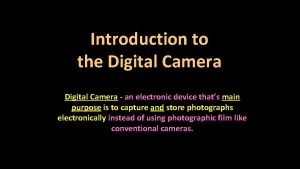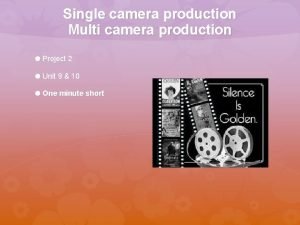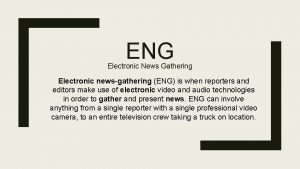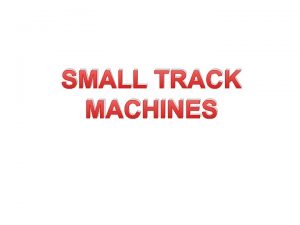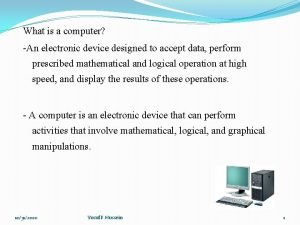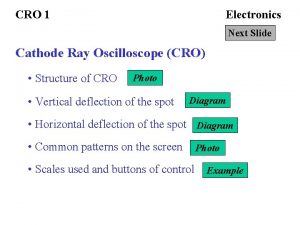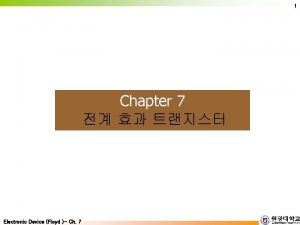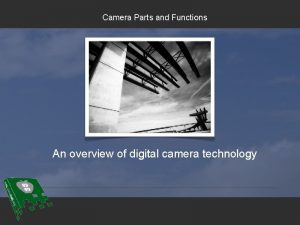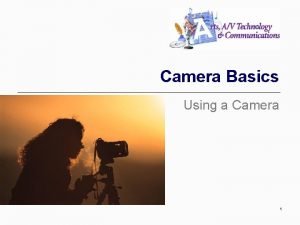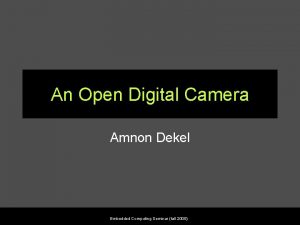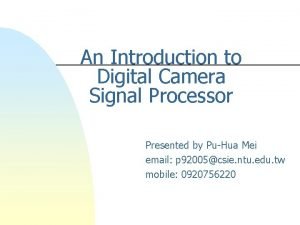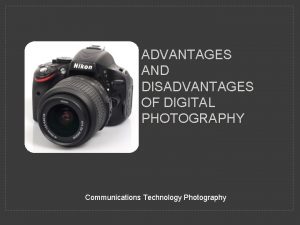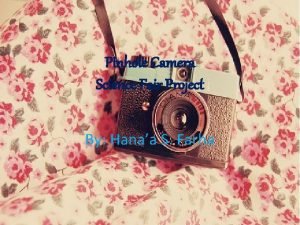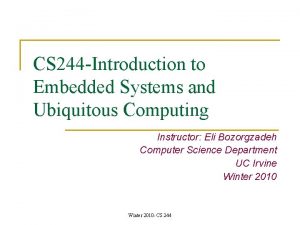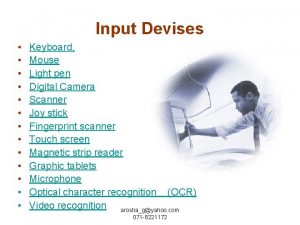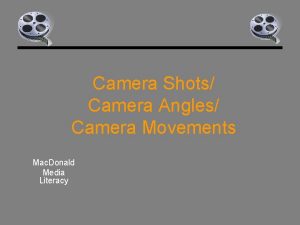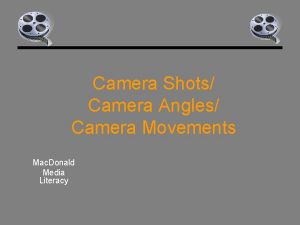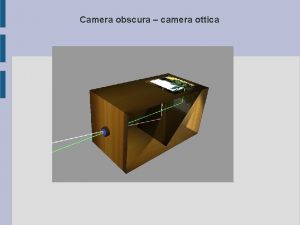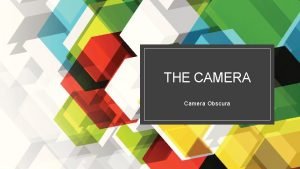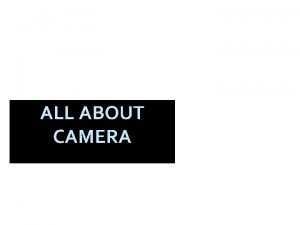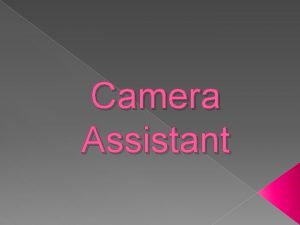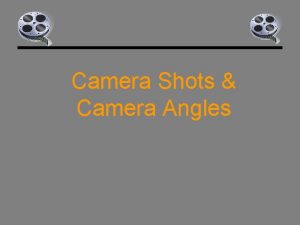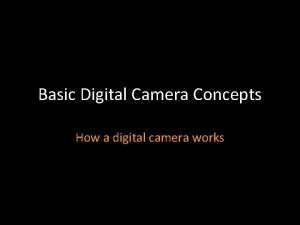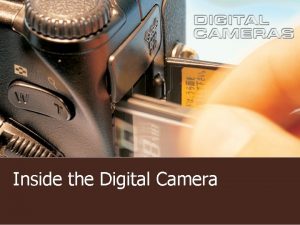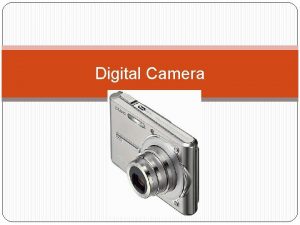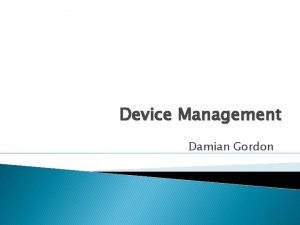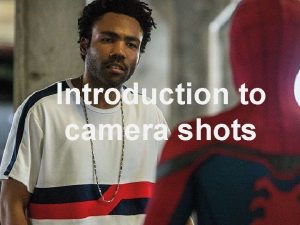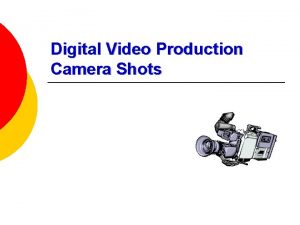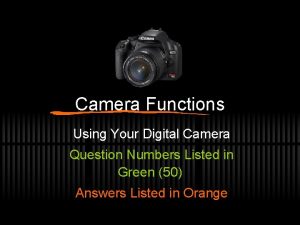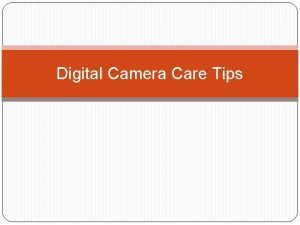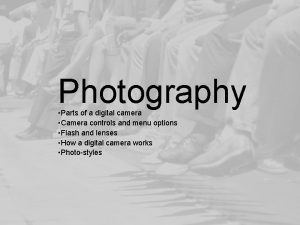Introduction to the Digital Camera an electronic device























- Slides: 23

Introduction to the Digital Camera - an electronic device that’s main purpose is to capture and store photographs electronically instead of using photographic film like conventional cameras.

Various Types of Digital Cameras DSLR (Digital Single Lens Reflex) Digital Point & Shoot Mirrorless Digital 2

Parts of a Digital Camera • Like a standard camera that uses film, digital cameras are still equipped with the following: – Lens – CCD (sensor) – Viewfinder and/or LCD screen – Built-in flash (although not all cameras have these) – Shutter Release Button – Aperture & Shutter Speed options – ISO Setting – Memory Storage & Battery component – Auto & Manual Modes

4

Lens • A series of convex- and concave-shaped glass elements used to produce undistorted image on film plane or charged coupled device (digital camera). • Charged coupled Device (CCD sensor) is hit by the light that enters the lens on the camera.

Understanding Lens Focal Lengths: Link to Nikon Resource 6

Charged Coupled Device • The CCD is an array (grid) of light-sensitive diodes. – When light strikes the diodes, an electrical charge is generated – This charge is converted to digital value (each digital value corresponds to a color) – Digital data is then compressed and stored on flash media (memory card) – The CCD is then reset for the next photo to be taken

Viewfinder • The window on the back of a camera that allows the photographer to see external objects to be photographed.

LCD Screen • On digital cameras, there is also an LCD screen, which allows you to see the external objects while holding the camera away from you. Sometimes this can show a more accurate reading of how the image will be cropped or the depth of field. 9

Built-in Flash • This triggers automatically in low light conditions when set to auto mode. • It is a device that produces an instantaneous flash of light (1/1000 of a second) at a color temperature to help illuminate a scene. Usually, this is when a scene does not have enough available light to adequately expose the photography.

Shutter Release Button • A mechanism that, when pushed down, causes the focal plane shutter to open & expose the film or the CCD. • In simple terms: the button you push to auto focus, then take the photo

Storage Space or Component • Film - any substance— usually translucent, like paper, plastic, or glass—which has been coated with light-sensitive silver halide salts. • Flash Media - a device which holds the digital information to construct an image. They offer high recordability, power-free storage, small form factor, and rugged environmental specifications. i. e. Memory card

What is Digital Photography? • Digital Photography – uses the electronic devices to record the image as binary data. This facilitates storage and editing of the images on personal computers, and also the ability to show and delete unsuccessful images immediately on the camera itself. • Main File Types: – RAW – JPEG 13

What’s the Difference? • RAW – this mode saves the image exactly as the camera captured it. – Advantage: The settings on your camera at the time the image was captured are saved inside the file, and with the right software you can actually go back and change everything from white balance to ISO settings after the picture is taken! – Disadvantage: RAW files are BIG and take up a tremendous amount of space on your memory card and on your hard drive. They also require special software to read. 14 • .

• JPEG – a compressed file format. – Advantage: Images captured in JPEG are much smaller than RAW files which means JPEG files are kind to your hard drive. – Disadvantage: subtle tonal differences may be lost during the compression process. Will you notice the difference? On large prints - maybe - if you know what you're looking for. On small prints like the 4 inch prints we get for everyday pictures you'll never see the difference 15

Units of Measurement • Byte - a unit of electronic storage • 1 MB = 1 million bytes • 1 GB = 1 billion bytes • Pixel - a single point in a graphic image. Short for picture element. • Usually digital images are compressed as a file ending with the extension: JPEG or JPG. Pixilated Example

CAMERA MODES 17

• Auto- an automatic point and shoot mode where the majority of settings are controlled by the camera in result to shooting conditions. This will adjust settings automatically to produce the best results with point and shoot simplicity. – In automatic mode, camera will: auto focus, decide if flash is needed, choose shutter speed and select aperture. • Portrait- shoots portraits with background in soft focus. Used to capture soft, natural-looking skin tones, if subject is far from background, background details will be softened and give composition a sense of depth.

• Landscape- preserves details in landscape shots. Uses the smallest aperture to capture sharp crisp results. – Built in flash will turn off automatically. • Close up- allows the photographer to take vivid close-ups of small objects. Use for closeups of flowers, insects, and any other small objects. Uses a larger aperture creating a shallow depth of field. – Camera will automatically focus on what is in the center of the frame.

• Sports- allows the photographer to stop motion. The camera will focus continuously while the shutterrelease button is pressed halfway, tracking the subject in the center focus area. – Camera selects high/fast shutter speeds to freeze subject in motion. With this setting, the flash is automatically turned off.

• Night Landscape- takes photos at night. Slow shutter speed is used to produce night landscapes. – The built in flash is turned off automatically, and a tripod should be used to prevent blur. • Night Portrait- take portraits against a dimly lit backdrop. Provides a natural balance between the main subject and the background taken in low light, also using a slow shutter speed.

• Self-Timer Mode- in Self-Timer Mode, the camera allows the photographer to take self-portraits and group shots. – Place camera on a tripod or any other stable, level surface. – Hold the shutter release button halfway down to focus, then all the way down to start the self-timer. – The light will blink and beep, two seconds before the photograph is taken, the blinking and beeping will become more rapid. Default self-timer is usually ten seconds. 22

>>>Next Power. Point: DOF & SS 23
 A digital camera is an electronic device
A digital camera is an electronic device Digital camera input process output
Digital camera input process output Internal input devices
Internal input devices Multi camera production examples
Multi camera production examples Single camera vs multi camera
Single camera vs multi camera Electronic news gathering camera
Electronic news gathering camera Is the electronic exchange of money or scrip
Is the electronic exchange of money or scrip Electronic news gathering and electronic field production
Electronic news gathering and electronic field production Small track machines
Small track machines Electronic logging device definition
Electronic logging device definition Perform surveillance without the aid of electronic device
Perform surveillance without the aid of electronic device A programmable electronic device designed to accept data
A programmable electronic device designed to accept data Electronic logging device definition
Electronic logging device definition Cro electronics
Cro electronics Electronic device
Electronic device Parts of camera obscura
Parts of camera obscura Video camera basics
Video camera basics Digital camera embedded system
Digital camera embedded system Digital camera processors
Digital camera processors Advantage and disadvantage of digital camera
Advantage and disadvantage of digital camera Digital pinhole camera science project
Digital pinhole camera science project Digital camera embedded system
Digital camera embedded system Digital camera input or output
Digital camera input or output Yahoo
Yahoo
